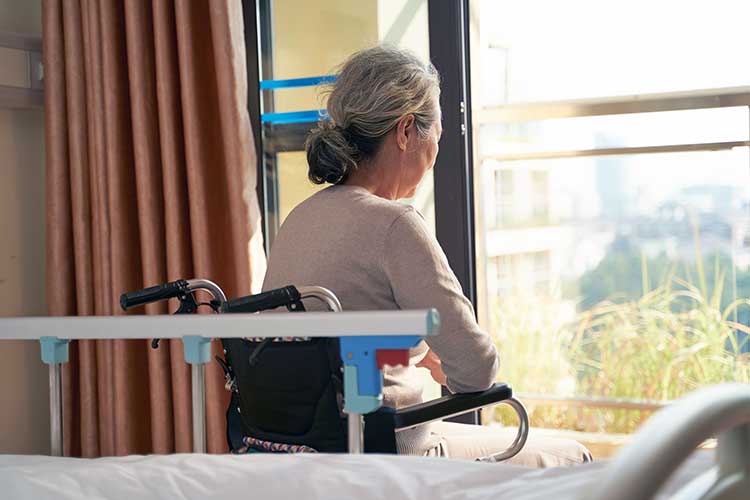Home care recipients, many of whom are older adults or living with disabilities, may be at increased risk of loneliness and social isolation.
Loneliness and social isolation are associated with poor physical and mental health, with research even suggesting they may increase the risk of premature death as much as obesity, smoking and physical inactivity (CDC 2021).
Therefore, ensuring that your clients feel adequately supported and connected is essential to optimising their health, wellbeing and overall quality of life.
Loneliness v Social Isolation
- Social isolation is the objective state of being in minimal contact with other people.
- Loneliness is the subjective feeling that you have less companionship, social contact or quality relationships with other people than you would like.
(AIHW 2024; Beyond Blue 2018)
Loneliness and social isolation can coexist; however, this is not always the case. These two terms, while similar, are distinct. It is possible for a socially isolated person to feel content or a socially connected person to feel lonely (AIHW 2024).
While loneliness may arise as an emotional response to being socially isolated, the quality of relationships seems to be more important overall than the number of social connections a person has (ACSA 2015).
It is important to note that loneliness varies in severity and is not always a significant issue. In some cases, the feelings may pass on their own. However, if an individual is experiencing constant loneliness that is causing self-reinforcing negative thoughts, this might be a serious problem (ACSA 2015).

Why are Older People at Risk of Loneliness and Social Isolation?
Older people may experience feelings of loneliness and social isolation due to a variety of factors, including:
- Living alone (27% of older people who live at home are living alone)
- The death of partners, family members or friends
- Widowhood, not being married or not having children
- Retirement
- Loss of driving licence or limited transport options
- Lack of facilities (e.g. appropriate footpaths)
- Chronic illness or disability
- Alzheimer’s disease or dementia
- Sensory impairment
- ‘Co-presence’ i.e. participating in day rooms, social activities or group outings where there is no opportunity to foster meaningful relationships.
(Beyond Blue 2018; CDC 2021; AIHW 2017; ASCA 2015)
Why are People Living With Disabilities at Risk of Loneliness and Social Isolation?
Studies have found that people living with disabilities have fewer friends and less social support and are overall more socially isolated than the general population (Emerson et al. 2021).
A 2017 report by the Jo Cox Commission on Loneliness in the UK found that about 23% of people living with disabilities feel lonely on a typical day, while 53% have experienced feelings of loneliness. This rises to 77% among young people living with disabilities.
Following the COVID-19 pandemic, two-thirds of people living with disabilities now say they often or always feel lonely (Kramer 2021).
Causes of loneliness and social isolation in people living with disabilities may include:
- Avoidance of social situations (one-third of Australians living with disabilities avoid certain situations due to their disability)
- Discrimination and stigma
- Lack of understanding and awareness from the general population
- Low levels of employment
- Mobility impairments that make it difficult to leave the house
- Difficulty using public transport
- Difficulty accessing buildings or facilities (e.g. shops, cafes, medical facilities)
- Lack of facilities (e.g. appropriate footpaths, wheelchair access)
- Lack of confidence to leave the house independently
- Fatigue caused by communicating with others (e.g. in people living with sensory impairment)
- Difficulty processing social information and language
- Poor mental health or mental illness
- Cognitive and communication difficulties
- Loss of confidence caused by symptoms such as drooling, incontinence or dysphagia
- Pain or fatigue
- Medicine side-effects
- Reduced access to technology, making it more difficult to establish online connections.
(AIHW 2024; The Jo Cox Commission on Loneliness 2017)
How Does Home Care Contribute to Loneliness and Social Isolation?
Home care can present unique challenges that may contribute to loneliness and social isolation. These may include:
- Difficulty maintaining identity and sense of self while simultaneously trying to avoid stigmatisation or being viewed as a burden
- Lack of autonomy
- Dependency
- Daily life being routinised.
(Neves et al. 2019)
The Impacts of Loneliness and Social Isolation
Loneliness and social isolation may have a variety of adverse effects, including:
- An increased risk of:
- Premature mortality
- Dementia
- Heart disease
- Stroke
- Depression, anxiety or suicide
- Hospitalisation
- Presentation to the emergency department
- Chronic pain
- Physical frailty
- Terminal illness
- Obesity
- High blood pressure
- Poor social relationships
- Increased care needs
- Reduced independence
- Reduced social participation
- Social exclusion
- Low social engagement
- Breakdown in relationships
- Decreased feeling of wellbeing
- Psychological distress
(CDC 2021; Beyond Blue 2018; Neves et al. 2019; AIHW 2024)
Building Rapport With Clients

Your visit to a client’s home might be the only social contact they have on that particular day. Therefore, building rapport and establishing a more meaningful relationship with your client might go a long way in helping them feel less isolated, or even just brightening up their day.
However, while your relationship with the client may be friendly, it must remain professional. Always be mindful of your professional boundaries and obligations.
Some ideas for appropriately building rapport include:
- Giving a genuine compliment about the client’s outfit, jewellery, home decor, furniture, wheelchair etc.
- Asking the client about photos or objects around their home.
- Taking interest in what the client has to say and talking to them about their hobbies.
- Asking appropriate questions. When you don’t know the client well, NSW (news/sports/weather) questions are usually safe options.
- Checking in on the client‘s mental health, especially if they are isolated.
- Sharing appropriate information about yourself such as your name, hobbies and interests. Avoid sharing overly personal information such as where you live or your personal, health or family problems.
- Being patient, even if the client is being uncooperative.
- Being empathetic and understanding.
- Practicing effective listening (e.g. maintaining eye contact, mirroring the client, keeping an open posture, nodding, paying attention and asking questions).
- Being respectful of the client’s home.
- Working collaboratively with the client.
- Maintaining a positive attitude while working.
(Todd 2013; Lowndes 2020)
Keep in mind that giving your client even just a few minutes of undivided attention goes a long way in building rapport and showing warmth (Lowndes 2020).
Recognising the Signs of Loneliness
In some cases, you might be the only person who is regularly visiting and interacting with the client. Therefore, it’s crucial that you are able to recognise signs of loneliness and depression, document any concerns and escalate care to appropriate healthcare professionals.
A client who is feeling lonely might display some of the following signs:
- Changes in appearance (e.g. unwashed clothes, unkempt hair, significant weight loss or gain)
- Neglect of self-care or daily tasks (e.g. closed blinds, unwashed dishes)
- Making negative comments about themself or their situation
- Mood changes
- Appearing drained or unmotivated
- Changes in sleep routine
- Lack of interest in communication, struggling to find the right words or forgetting what they are saying mid-sentence
- Concentration difficulties, inability to keep up with conversations, disengagement or restlessness
- Memory loss, confusion or appearing overwhelmed.
(Home Instead 2023; Nurse Next Door 2022; Adams 2020)

Conclusion
Loneliness and social isolation have the potential to significantly adversely affect a person’s physical and mental health. To ensure your clients feel well-connected, it is important to understand why loneliness may arise and know how to help them overcome these feelings.
Keep in mind that interventions should be tailored to suit each client, as loneliness is a subjective and individual experience that can not be addressed using a one-size-fits-all approach (Fakoya et al. 2020).
Test Your Knowledge
Question 1 of 3
How can the term loneliness be defined?
Topics
References
- Aged and Community Services Australia 2015, Social Isolation and Loneliness Among Older Australians, ACSA, viewed 19 July 2024, https://www.acsa.asn.au
- Australian Institute of Health and Welfare 2017, Australia’s Welfare 2017: 5.1 Ageing and Aged Care, Australian Government, viewed 19 July 2024, https://www.aihw.gov.au
- Australian Institute of Health and Welfare 2024, People With Disability in Australia, Australian Government, viewed 19 July 2024, https://www.aihw.gov.au
- Australian Institute of Health and Welfare 2024, Social Isolation and Loneliness, Australian Government, viewed 19 July 2024, https://www.aihw.gov.au
- Beyond Blue 2018, Connections Matter: Helping Older People Stay Socially Active, Beyond Blue, viewed 19 July 2024, https://edge.sitecorecloud.io
- Centers for Disease Control and Prevention 2021, Loneliness and Social Isolation Linked to Serious Health Conditions, U.S. Department of Health & Human Services, viewed 19 July 2024, https://www.cdc.gov
- Emerson, E, Fortune, N, Llewellyn, G & Stancliffe, R 2021, ‘Loneliness, Social Support, Social Isolation and Wellbeing Among Working Age Adults with and Without Disability: Cross-sectional Study’, Disabil Health J., vol. 14, no. 1, viewed 19 July 2024, https://www.ncbi.nlm.nih.gov
- Fakoya, OA, McCorry, NK & Donnelly, M 2020, ‘Loneliness and Social Isolation Interventions for Older Adults: A Scoping Review of Reviews’, BMC Public Health, vol. 20 no. 129, viewed 19 July 2024, https://bmcpublichealth.biomedcentral.com
- Home Instead 2023, 5 Signs an Aging Adult is Experiencing Loneliness, Home Instead, viewed 19 July 2024, https://www.homeinstead.com
- The Jo Cox Commission on Loneliness 2017, “Someone Cares if I’m Not There”: Addressing Loneliness in Disabled People, Sense, viewed 19 July 2024, https://www.sense.org.uk
- Kramer, R 2021, ‘How we’re Tackling Loneliness’, Talking Sense Blog, 19 November, viewed 19 July 2024, https://www.sense.org.uk
- Lowndes, G 2020, Care Workers: How To Build Rapport With New Clients, HomeCare Australia, viewed 19 July 2024, https://www.homecareaustralia.com.au
- Neves, BB, Sanders, A & Kokanović, R 2019, ‘ “It's the Worst Bloody Feeling in the World”: Experiences of Loneliness and Social Isolation Among Older People Living in Care Homes’, Journal of Aging Studies, vol. 49, viewed 19 July 2024, https://bbneves.com
- Nurse Next Door 2022, ‘Ways to Alleviate Loneliness and Depression In Older Australians’, The Caring Journal, viewed 19 July 2024, https://www.nursenextdoor.com.au
- Todd 2013, ‘7 Tips Caregivers Can Instantly Use To Deepen Rapport With Their Clients’, Health Care Associates, 14 May, viewed 19 July 2024, https://healthcareassociates.net

